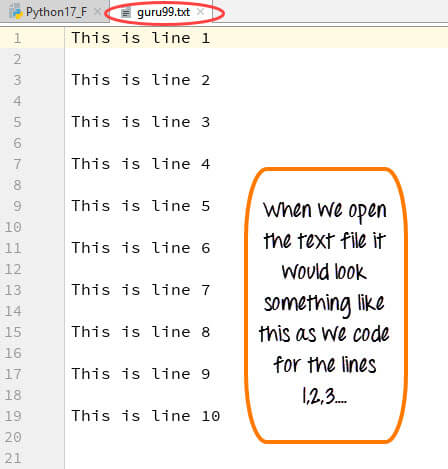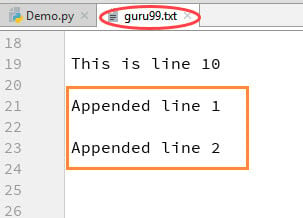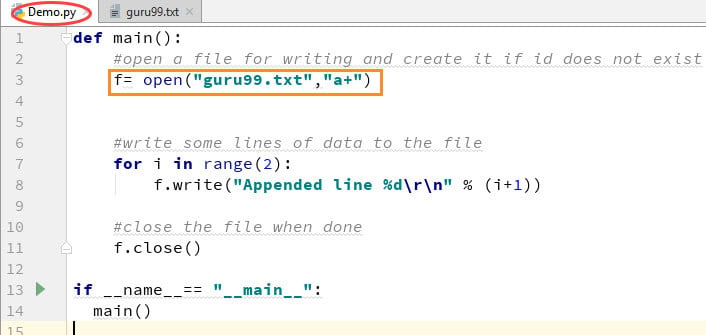Python File Handling
In Python, there is no need to bring external libraries to read and write files. Python provides structural work for creation, reading and file files.
This training, I will learn
• How to create a text file
• How to Append data to a file
• How to read the file
• How to read a file line by line
• File Modes in Python
How to create a text file
With Python you can create a .text (Python.txt) using the code, we must show how this can be done.
Step 1)
f= open("guru99.txt","w+")
•We have declared the variable in the file name of textfile.txt. Go to take 2 reasons, the file you want to go to a chain representing a different authorization or working on how to make a file
• Following the statements we use the "w" letter in the debate, the authors have shown the extra sign that means you will create a file if it is not in the library
• Possible opportunities for "w" are "r" to read "a" to add a combination of symbols meaning that if it is to be done,
Step 2)
for i in range(10):
f.write("This is line %d\r\n" % (i+1))
• We have a new round with 10 points.
• Use the action to record data to insert the file.
• The question we want to pass on the file is "this is a complete line", we declare the action and then we have a hundred d (show emotions)
• Usually, we post the numbers on the strings that we write and write your new lines on the new lines
Step 3)
f.close()
Here is the result after the code request

When you click on your text file in our case "Python.txt" it will look something like this

How to Append data to a file
You can also add a new folder for the file or new folder.
Step 1)
f=open("guru99.txt", "a+")
Again, if you see an additional number on the number, it shows that a new file will be created if there is none. But if we have the file, so there is no need to make a new folder.
Step 2)
for i in range(2):
f.write("Appended line %d\r\n" % (i+1))
This will put open file open source files.
You can see the result of the "Python.txt" file. The code is created before it is attached to the new data.

How to read the file
Not only can you make a .txt file from Python, but you can also call the .txt file in the reader format (r).
Steps 1) Open the file to the reader
f=open("guru99.txt", "r")
Step 2) We use the code function to make sure that the files that are already formatted. If so, let's move
if f.mode == 'r':
Step 3) Use f.read to read the file folder and store it effectively
contents =f.read()
Step 4) Here is where to go
How to read a filing strip

How to Read a File line by line
You can also read the file line by line .txt if your data is too big to read. This article will provide you with a simple and easy-to-read data

When the code is executed (F1 = f.readlines ()) to read a filing strip of the line or document, each line is sorted, the file is in a readable format. If our events are short and read, the output is the same as the reading style. But if there is a hard copy file that can not be read, this code may be useful.
Summary:
• Python lets you read, write, and delete files
• Use open source ("file folder", "w +") to create a file. The mark + tells you to write the Python file if there is one
• To file a file by using the open order ("filename", "a")
• Use reading readings to read the contents of the file
• Use the reader-captions read one of the files in one file.

Comments
Post a Comment